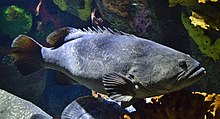Giant grouper
| Giant grouper | |
|---|---|

| |
| Giant grouper at Ripley's Aquarium of Canada | |
| Scientific classification | |
| Domain: | Eukaryota |
| Kingdom: | Animalia |
| Phylum: | Chordata |
| Class: | Actinopterygii |
| Order: | Perciformes |
| Family: | Serranidae |
| Subfamily: | Epinephelinae |
| Genus: | Epinephelus |
| Species: | E. lanceolatus
|
| Binomial name | |
| Epinephelus lanceolatus (Bloch, 1790)
| |
| Synonyms[2] | |
| |
The giant grouper (Epinephelus lanceolatus), also known as the Queensland groper (grouper), brindle grouper or mottled-brown sea bass, is a species of marine
Description

The giant grouper has a robust body which has a
Distribution
The giant grouper has a wide
Habitat and biology
The giant grouper is a species of shallow water and can be found at depths of 1 to 100 metres (3.3 to 328.1 ft). It is associated with reefs and is the largest known bony fish found on reefs.
Reproduction
Like most groupers, giant groupers are
Taxonomy
The giant grouper was first formally
Utilisation
The giant grouper is a highly valued food fish and is taken by both commercial and recreational fisheries. As well as the consumption of its flesh its skin, gall bladder and stomach are used in
Cultural references
The first fish to undergo chemotherapy was Bubba, a giant grouper at the Shedd Aquarium in Chicago.[10]
References
- ^ . Retrieved 19 November 2021.
- ^ a b c d e Froese, Rainer; Pauly, Daniel (eds.) (2019). "Epinephelus lanceolatus" in FishBase. December 2019 version.
- ^ ISBN 92-5-103125-8.
- ^ a b Bray, D.J. (2019). "Epinephelus lanceolatus". Fishes of Australia. Museums Victoria. Retrieved 9 July 2020.
- ^ a b c "Epinephelus lanceolatus (giant grouper)". CAB International. Retrieved 9 July 2020.
- ^ a b "Giant Queensland groper". Department of Primary Industries. State of New South Wales. Retrieved 9 July 2020.
- .
- .
- ^ Eschmeyer, William N.; Fricke, Ron & van der Laan, Richard (eds.). "Holocentrus lanceolatus". Catalog of Fishes. California Academy of Sciences. Retrieved 9 July 2020.
- ^ "'Bubba,' Famed Cancer-surviving Grouper, R.I.P.; 'Overcame Some Incredible Odds'". Underwatertimes.com News Service. Underwatertimes. 2006-08-24. Retrieved 27 May 2012.
External links
- Epinephelus lanceolatus on the Integrated Taxonomic Information System
- Queensland Groper, Epinephelus lanceolatus from the Australian Museum
- Photos of Giant grouper on Sealife Collection

